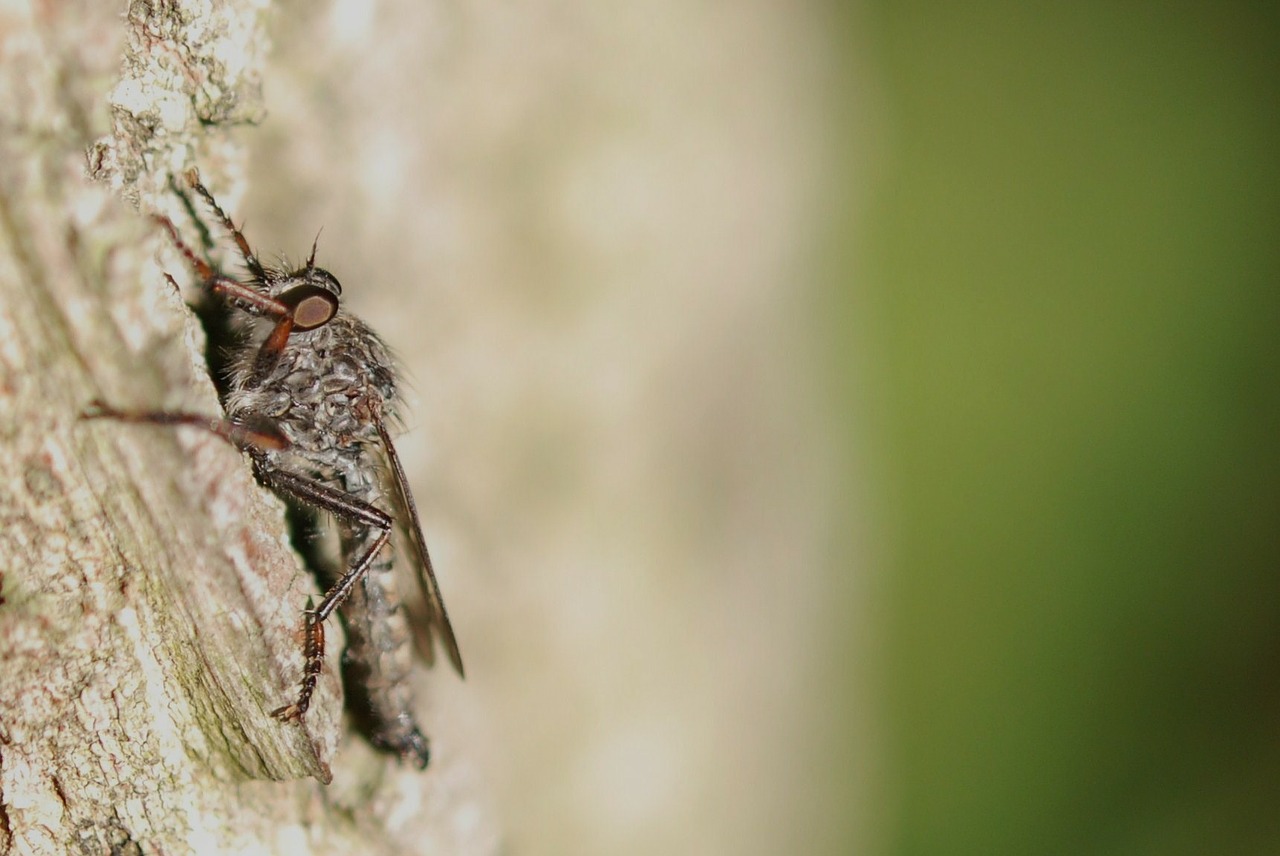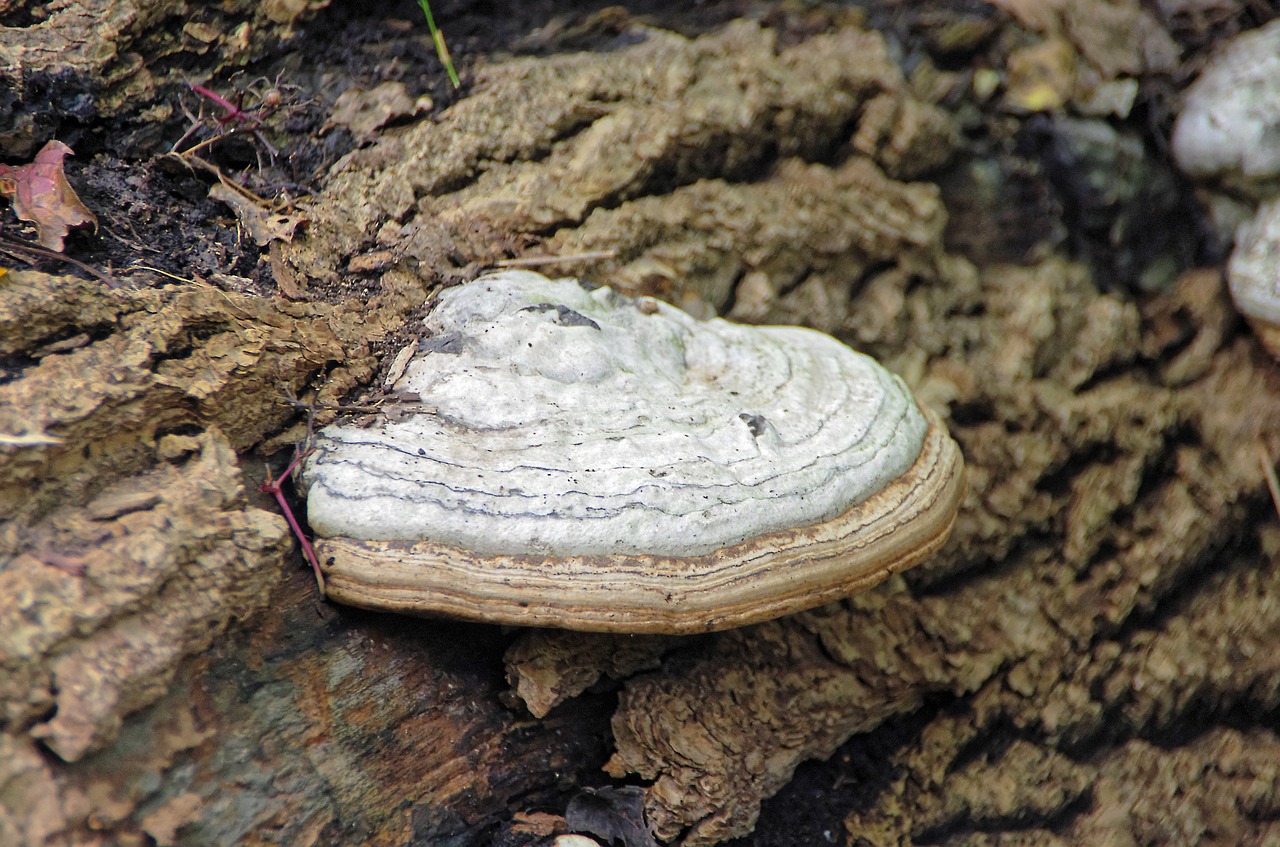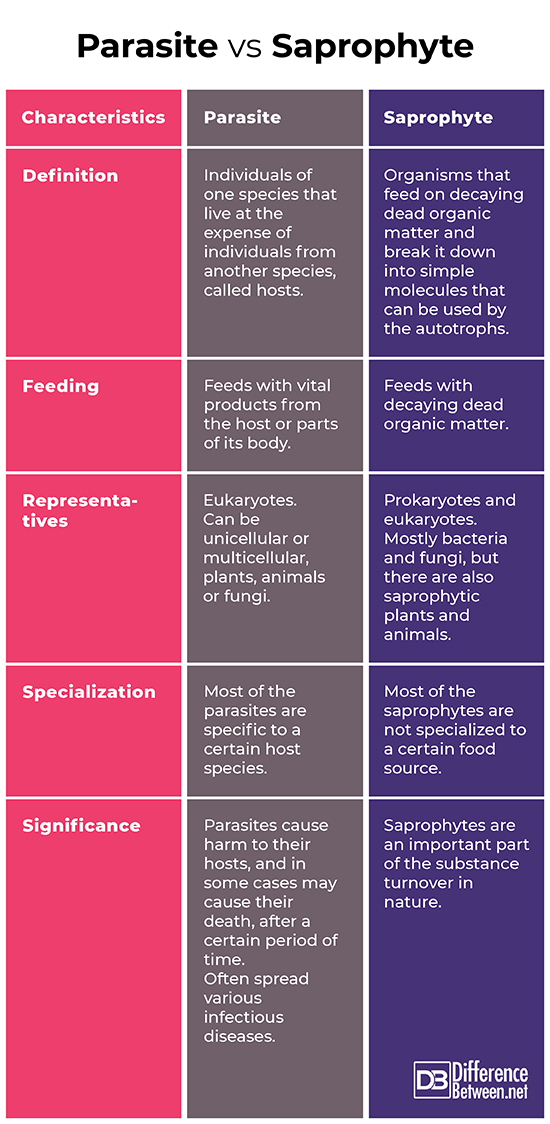Difference Between Parasite and Saprophyte
Parasites live at the expense of another species, called hosts. Saprophytes feed on decaying dead organic matter and they help break down the decaying organic substances into simple molecules.
What is Parasite?
Parasites are individuals of one species that live at the expense of individuals from another species, called hosts. The parasite feeds with vital products from the host (e.g. parasite worms, receiving nourishment in the hosts’ digestive system) or parts of its body (e.g. the mosquitoes, drinking blood) while it is alive. In addition to a food source, the host may also provide a habitat to the parasite.
Parasites cause harm to their hosts, and in some cases may cause their death, but after a certain period of time. They often spread various infectious diseases.
By the term “parasites” are meant only eukaryotic organisms, although viruses and pathogenic bacteria also have a parasitic way of life. Parasites are unicellular or multicellular organisms, fungi, plants or animals. Hosts may be plants, animals or fungi.
Depending on whether the parasites feed / live on the surface of the host’s body or in it, they are divided into ectoparasites (e.g. ticks) and endoparasites (e.g. tapeworms).
Depending on the way of residence, the parasites may be temporary (e.g. ticks) or permanent (e.g. tapeworms).
Depending on whether at least one the life stages of a species is mandatorily parasitic the parasites may be facultative parasites or obligate parasites. The facultative parasites may live and feed independently, but if they fall in an appropriate host they may switch to parasitism.
Parasites have special adaptations for this way of life. Some parasites are specific to a certain host species, others can use different species as hosts.
What is Saprophyte?
Saprophytes are organisms that feed on decaying dead organic matter. They break down the decaying organic substances into simple molecules that can be used by plants and are an important part of the substance turnover in nature.
Green plants form organic substances from inorganic ones. The formed organic substances serve as food for the herbivorous animals, which, themselves, are food for the carnivores. The bodies of dead plants and animals are degraded by saprophytic organisms and converted into inorganic substances that can be used by plants in the synthesis of organic substances.
Thus, the saprophytes play a crucial role in the substance turnover in nature, as they decompose dead tissue into components that can be used by other organisms.
Saprophytes work efficiently and, in optimal warm and humid conditions, may break down dead organic matter within 24 hours. In a colder and less humid environment, the process of decomposition is slower.
Saprophytes are prokaryotes and eukaryotes. Most of the saprophytes are bacteria and fungi, but there are also saprophytic plants and animals.
Saprophytes use a particular digestion mechanism, called extra-cellular digestion. They secrete digestive substances into the environment. After they break down the decaying matter into simple substances, the saprophytes absorb them. Depending on the species, saprophytes decompose complex organic substances to simpler ones or directly to inorganic ones.
Difference Between Parasite and Saprophyte
Definition
Parasite: Parasites are individuals of one species that live at the expense of individuals from another species, called hosts.
Saprophyte: Saprophytes are organisms that feed on decaying dead organic matter and break it down into simple molecules that can be used by the autotrophs.
Feeding
Parasite: The parasite feeds with vital products from the host (e.g. parasite worms, receiving nourishment in the hosts’ digestive system) or parts of its body (e.g. the mosquitoes, drinking blood).
Saprophyte: The saprophytes feed on decaying dead organic matter.
Representatives
Parasite: Parasites are eukaryotes. They can be unicellular or multicellular, plants, animals or fungi.
Saprophyte: Saprophytes are prokaryotes and eukaryotes. Most of the saprophytes are bacteria and fungi, but there are also saprophytic plants and animals.
Specialization
Parasite: Parasites have special adaptations for this way of life. Most of the parasites are specific to certain host species.
Saprophyte: Saprophytes have special adaptations for this way of life. Most of the saprophytes are not specialized to a certain food source.
Significance
Parasite: Parasites cause harm to their hosts, and in some cases may cause their death, but after a certain period of time. They often spread various infectious diseases.
Saprophyte: The bodies of dead plants and animals are degraded by saprophytic organisms and converted into inorganic substances that can be used by plants in the synthesis of organic substances. Saprophytes are an important part of the substance turnover in nature.
Parasite vs. Saprophyte
Summary:
- Parasites are individuals of one species that live at the expense of individuals from another species, called hosts.
- Saprophytes are organisms that feed on decaying dead organic matter and break it down into simple molecules that can be used by the autotrophs.
- The parasite feeds with vital products or parts of the body of the host while it is alive. The saprophytes feed on decaying dead organic matter.
- Parasites are eukaryotes, while saprophytes can be prokaryotes and eukaryotes.
- Parasites can be unicellular or multicellular, plants, animals or fungi. Most of the saprophytes are bacteria and fungi, but there are also saprophytic plants and animals.
- Parasites and saprophytes have special adaptations for this way of life. Most of the parasites are specific to certain host species, while most of the saprophytes are not specialized to a certain food source.
- Parasites cause harm to their hosts, and in some cases may cause their death, after a certain period of time. They often spread various infectious diseases. Saprophytes are an important part of the substance turnover in nature.
- Difference Between Gallstones and Cholecystitis - September 5, 2021
- Difference Between Constipation and Cramping - August 4, 2021
- Difference Between Whole Genome Sequencing and Microarray - May 6, 2021
Search DifferenceBetween.net :
Leave a Response
References :
[0]Dube, H. Textbook of Fungi, Bacteria and Viruses. Mumbai: Promilla Publisher. 2007. Print.
[1]Elevitch, C. The Overstory Book: Cultivating Connections with Trees. Holualoa: Permanent Agricultural Resources. 2004. Print.
[2]Lucius, R., B. Loos-Frank, R. Lane, R. Poulin, C. Roberts, R. Grencis. The Biology of Parasites. Hoboken: John Wiley & Sons. 2017. Print.
[3]Image credit: https://pixabay.com/photos/chaga-fungus-saprophyte-deadwood-2870598/
[4]Image credit: https://pixabay.com/photos/fly-insect-parasite-pest-dirty-22297/



